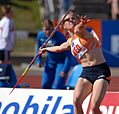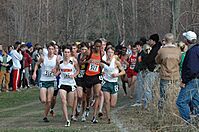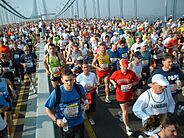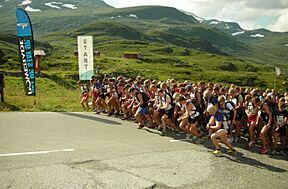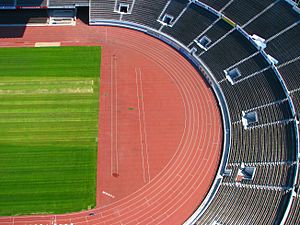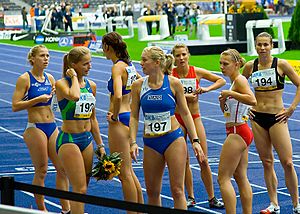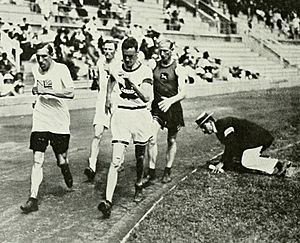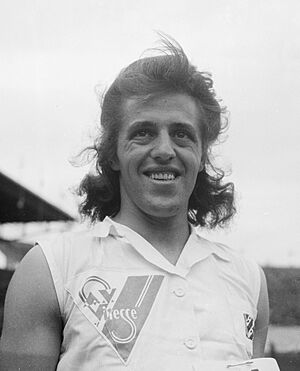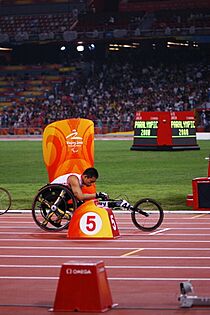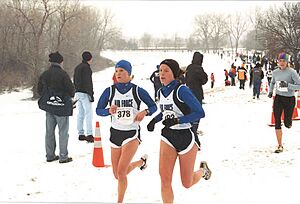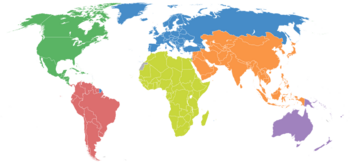Sport of athletics facts for kids
|
|
|
| Highest governing body | World Athletics |
|---|---|
| Characteristics | |
| Mixed-sex | Yes |
| Type | Outdoor or indoor |
| Presence | |
| Olympic | Present since inaugural 1896 Olympics |
| Paralympic | Present since inaugural 1960 Paralympics |
Athletics is a group of exciting sports. It includes competitive running, jumping, throwing, and walking. The main types of athletics competitions are track and field, road running, cross-country running, and racewalking.
In racing events, winners are decided by who finishes first. Sometimes, it's about the fastest time. For jumps and throws, the winner is the athlete who jumps the highest or furthest. Athletics is popular worldwide because it's simple and doesn't need expensive gear. It's mostly an individual sport. But relay races and team events, like cross country, also exist.
Organized athletics started way back in the Ancient Olympic Games in 776 BC. The rules for modern athletics were set in Europe and North America in the 1800s and early 1900s. Then, these rules spread globally. Today, most big competitions are run by World Athletics. This is the main group that manages the sport around the world.
Athletics is a key part of the Summer Olympics. The biggest international event is the World Athletics Championships. This includes track and field, marathon running, and race walking. Other major events are the World Athletics Cross Country Championships and the World Athletics Road Running Championships. Athletes with a physical disability compete in the Summer Paralympics and the World Para Athletics Championships.
The word "athletics" comes from ancient Greek. It means "a person who competes for a prize." In the 1800s, it started meaning sports like running, walking, jumping, and throwing. This meaning is still common in the United Kingdom and other places.
In North America, "athletics" often means sports in general. People there usually say "track and field" when talking about these specific events. This includes race-walking and marathon running. Cross country running is often seen as a separate sport there.
Contents
History of Athletics
Ancient Athletics
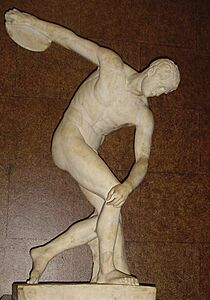
Running, walking, jumping, and throwing contests are some of the oldest sports. They go back to prehistoric times. Pictures of athletics events are found in Ancient Egyptian tombs from 2250 BC. These show running at the Heb Sed festival and high jumping. The Tailteann Games were an old Celtic festival in Ireland. Started around 1800 BC, they included running and stone-throwing.
The very first event at the first Olympics in 776 BC was a stadium-length running event called the stadion. Later, throwing and jumping events were added as part of the ancient pentathlon. Other Panhellenic Games, started around 500 BC, also had athletics competitions.
Modern Athletics
The Cotswold Olympic Games in 17th-century England featured athletics. They had contests like sledgehammer throwing. From 1796 to 1798, France held L'Olympiade de la République. This was an early version of the modern Olympics. It mainly featured running, but also other ancient Greek sports. The 1796 Olympiade was the first time the metric system was used in sports.
Organized athletics competitions began in the 1800s. The Royal Military College, Sandhurst held events around 1812. In 1840, the Royal Shrewsbury School Hunt in Shrewsbury also had competitions. The Royal Military Academy at Woolwich held an organized event in 1849. Exeter College, Oxford started regular meetings for students in 1850. The annual Wenlock Olympian Games, first held in 1850 in Wenlock, England, also included athletics.
The first indoor athletics meetings started in the 1860s. One meet in London had running and triple jump events.
The Amateur Athletic Association (AAA) was formed in England in 1880. It was the first national group for athletics. They started their own yearly competition, the AAA Championships. The United States also began a national competition, the USA Outdoor Track and Field Championships, in 1876. Athletics rules became more standard in the late 1800s. Groups like the Amateur Athletic Union (US, 1888) and the Union des sociétés françaises de sports athlétiques (France, 1889) helped with this.
Athletics was part of the first modern Olympic Games in 1896. It has been a main sport ever since. At first, only men competed. But in the 1928 Olympics, women's events were added. Athletics has also been part of the Paralympic Games since they began in 1960. Athletics is very popular during big championships like the Olympics.
An international group, the International Amateur Athletics Federation (IAAF), started in 1912. For much of the 1900s, it kept sports amateur. This meant athletes couldn't earn money. But professional competitions slowly became more common. In the 1970s, the International Track Association even formed a professional circuit in the US. Athletes wanted to be paid. The IAAF responded by creating the IAAF Golden Events and the outdoor World Athletics Championships in 1983. This included track and field, racewalking, and marathon. Today, athletes can earn money, ending the "amateur" rule. The global group changed its name to the International Association of Athletics Federations in 2001. In 2019, it became World Athletics.
The Comité International Sports des Sourds was formed by 1922. It manages international sports for deaf athletes, including athletics.
Organized international competitions for athletes with a physical disability (not deaf) began in 1952. The first international Stoke Mandeville Games were for World War II veterans. These only included athletes in wheelchairs. This led to the first Paralympic Games in 1960. Over time, competitions grew to include athletes with amputations, cerebral palsy, and visual impairments.
Athletics Events
World Athletics, the sport's main group, divides athletics into six types. These are track and field, road running, race walking, cross country running, mountain running, and trail running. Mountain running was added in 2003, and trail running in 2015.
Most athletics events are individual sports. This means athletes compete alone. But relay races are an exception. Also, at international championships, athletes' scores are often added up by country. In cross country and road races, top athletes' finishing spots or times can be combined for a team score.
Some other types of running exist outside World Athletics' rules. The International Skyrunning Federation (ISF) manages high-altitude mountain running, called skyrunning. Competitive stair climbing is known as vertical running or tower running. Snowshoe running is a winter sport where athletes wear snowshoes to race over deep snow. The International Association of Ultrarunners organizes ultra running. These are very long-distance races.
Track and Field
Track and field events started in the late 1800s. They were often held between schools, military groups, and sports clubs. Athletes can compete in one or more events. Men and women compete separately. Track and field happens both indoors and outdoors. Indoor events are usually in winter, while outdoor events are mostly in summer. The sport is named after where it's held: the athletics stadium.
Many running events happen on the track. They fall into three distance groups: sprints (short), middle-distance, and long-distance track events. Relay races have teams of four runners. They pass a baton to their teammate after a certain distance. The goal is to be the first team to finish. Hurdling events and the steeplechase involve athletes clearing obstacles on the track.
Field events are either jumping or throwing competitions. In throwing events, athletes throw an object as far as they can. Common throwing events are the shot put, discus, javelin, and hammer throw. There are four main jumping events. The long jump and triple jump measure how far an athlete can jump horizontally. The high jump and pole vault measure how high they can jump.
Combined events include the decathlon (for men) and heptathlon (for women). In these, athletes compete in several different track and field events. Each performance earns points, which are added up for a final score.
The most important track and field contests are at athletics championships and multi-sport events. The Olympic athletics competition and World Championships in Athletics are the highest levels. The Paralympic athletics competition and World Para Athletics Championships are also very important. Track and field events are the most famous part of major athletics championships. Many well-known athletes come from this area.
Smaller track and field competitions happen at national championships. There are also yearly, invitational track and field meets. These range from elite events like the IAAF Diamond League to local school events.
| Track | Field | Combined events | |||||
|---|---|---|---|---|---|---|---|
| Sprints | Middle-distance | Long-distance | Hurdles | Relays | Jumps | Throws | |
| 60 m 100 m 200 m 400 m |
800 m 1500 m 3000 m |
5000 m 10,000 m |
60 m hurdles 100 m hurdles 110 m hurdles 400 m hurdles 3000 m steeplechase |
4 × 100 m relay 4 × 400 m relay |
Long jump Triple jump High jump Pole vault |
Shot put Discus throw Hammer throw Javelin throw |
Pentathlon Heptathlon Decathlon |
- Note: Events in italics are competed at indoor world championships only
- Note: Heptathlon can refer to two different events, each consisting of different disciplines and both recognised by IAAF: the indoor heptathlon for men, and the outdoor heptathlon for women.
Road Running
Road running competitions are mostly long-distance races. They happen on paved or tarmac roads. Big events often finish on a track inside a main stadium. Road running is a common recreational sport. At the elite level, especially marathon races, it's one of the most popular parts of athletics.
Road races can be almost any distance. But the most common are the marathon, half marathon, 10 km, and 5 km. The marathon is the only road running event at the IAAF World Championships in Athletics and the Summer Olympics. There is also a yearly IAAF World Half Marathon Championships. The marathon is also the only road running event at the World Para Athletics Championships and the Summer Paralympics. The World Marathon Majors series includes the six most famous marathons: Berlin, Boston, Chicago, London, New York City, and Tokyo Marathons.
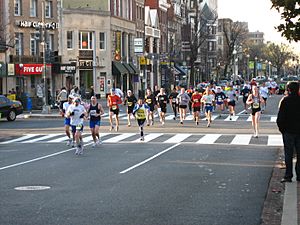
Road running started with "footmen" in the 1700s. These male servants ran next to noble people's carriages. They also ran errands over long distances. Foot racing competitions grew from bets between nobles. They would bet on whose footman was faster. The sport became professional as footmen were hired just for their running skills. They trained hard for these betting events.
In the late 1800s, the amateur sports movement changed things. It pushed aside competitions based on professional betting. The 1896 Summer Olympics saw the start of the modern marathon. This event led to more road running competitions. Examples include the Boston Marathon (first held in 1897) and the Lake Biwa Marathon and Fukuoka Marathons (started in the 1940s). The running boom of the 1970s in the United States made road running a popular hobby. It also made it more popular at the elite level.
Ekiden contests are a type of marathon relay race. They started in Japan and are still very popular there. This is different from most road running, which is individual.
Cross Country Running
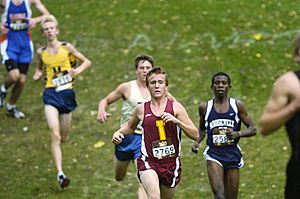
Cross country running is the most natural type of athletics. Competitions happen outdoors on surfaces like grass, woodland trails, and earth. It's both an individual and team sport. Runners are judged individually, but a points system is used for teams. Races are usually long distance, 3 km (1.9 mi) or more. They are often held in autumn and winter. The best cross country athletes also often compete in long-distance track and road events.
The Crick Run in England in 1838 was the first organized cross country race. The sport became popular in British and American schools in the 1800s. This led to the first International Cross Country Championships in 1903. The yearly IAAF World Cross Country Championships started in 1973. This is still the highest level of competition for the sport. There are also continental championships in Asia, Europe, North America, and South America. The sport is still popular in schools, especially in the UK and US. At the professional level, the main competitions are part of the IAAF Cross Country Permit Meetings.
Cross country competitions are no longer in the Olympics. They were part of the athletics program from 1912 to 1924. But it has been an event in the modern pentathlon since the 1912 Summer Olympics. A different type of cross country is mountain running. This includes big uphill and downhill parts, making the course harder. Fell running and Orienteering are similar sports. But they involve navigation, which cross country does not.
Racewalking
Racewalking is a type of competitive walking. It usually happens on open roads, but sometimes on running tracks. It's the only athletics sport where judges watch athletes' technique. Racewalkers must always have one foot on the ground. Their front leg must be straight, not bent at the knee. If they don't follow these rules, they are disqualified.
Racewalking started with "pedestrianism" in the late 1700s in England. People would bet on who would win walking races. The sport became about endurance. Competitions were over long distances. Or walkers had to cover a certain distance in a set time. For example, Centurion contests involved walking 100 miles (160 km) in 24 hours. During this time, racewalking was often held on athletics tracks. This made it easy to measure distances.
The 1908 Summer Olympics in London added the 3500-meter and 10-mile walks. Racewalking was briefly removed from the Olympics in 1928. But the men's 50 kilometres race walk has been in almost every Olympic Games since 1932. The men's 20 kilometres race walk was added in 1956. The women's event first happened in 1992. Today, common events are 10 km, 20 km, and 50 km on roads. Women's 3 km and men's 5 km races are held on indoor tracks.
The highest level racewalking competitions are at the IAAF World Championships in Athletics and the Summer Olympics. But the sport also has its own big competition: the IAAF World Race Walking Cup. This has been held since 1961. The IAAF World Race Walking Challenge is the main yearly competition. Athletes earn points for their results in ten chosen races. The top walkers compete in that year's IAAF Race Walking Challenge Final.
Categories in Athletics
People have very different abilities in athletics. So, many competitive categories have been created. This helps athletes compete against others of similar skill. It also includes groups who might not be competitive in open events. Besides physical traits, some competitions have rules about nationality or group membership.
Men's and Women's Divisions
In athletics, men and women almost always compete only against people of the same sex.
Age Groups
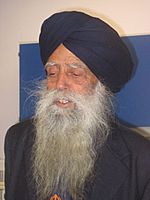
Age greatly affects how well someone can compete in athletics. Athletic ability usually grows through childhood and teen years. It peaks in early adulthood. Then, it slowly declines from about age 30. Because of this, many age categories exist. They encourage younger and older athletes to compete.
At the international level, there are three main groups for young athletes: under-23, under-20 (formerly junior), and under-18 (formerly youth). Beyond international rules, different youth categories are used. These are often two-year or single age groups.
Age categories are more detailed for older athletes. These are usually part of masters athletics. This has age groups every five years for all athletes aged 35 and older. There's no limit to how many age groups there can be. For example, Stanisław Kowalski holds a world record for men aged 105 and over.
For competitions where age isn't a factor, it's called senior or open class athletics. International rules still limit younger people in endurance events for health reasons.
Athletes' age for a group is usually checked with official papers like birth records. Sometimes, "age cheating" has happened at global age-category championships. One famous case was Olympic medalist Thomas Longosiwa. He used a fake passport to compete at the 2006 World Junior Championships in Athletics when he was 24. Age cheating in youth groups mostly happens in less developed parts of the world. These areas might have fewer checks on official papers. Also, some older athletes compete in high school events due to schooling problems. The same regions also have issues with age checks in masters categories. For example, Indian distance runners Dharampal Singh Gudha and Fauja Singh (both claiming to be over 100) gained public attention.
Athletes with Disabilities
Athletes with physical disabilities have competed in separate international events since 1952. The International Paralympic Committee manages athletics competitions. It hosts the Paralympic Games, which have continued since 1960.
In elite competitions, athletes are grouped by their disability. This puts athletes with similar disabilities in the same event. For example, a T12 athlete is a track athlete with a visual impairment.
- F = Field athletes
- T = Track athletes
- 11–13 – visual impairment. They compete with a sighted guide.
- 20 – Intellectual disability
- 31–38 – cerebral palsy
- 40–46 – amputation, and others (including athletes with dwarfism)
- 51–58 – Wheelchair athletes
Deaf athletes have their own long history of organized athletics. The first major world competition was at the 1924 Deaflympics. The main challenge for deaf athletes in regular athletics is sound-based parts of the sport. For example, the starter's pistol. This can be a problem even in Paralympic sport. Olivia Breen, who is deaf, missed a false start in a cerebral palsy race at the 2012 Paralympics.
In wheelchair racing, athletes use special lightweight racing chairs. Most major marathons have wheelchair divisions. Elite wheelchair racers often finish faster than runners on foot. The speed of wheelchair racers has made it hard for race organizers. They need to properly space out their start times from runners. A crash between Josh Cassidy (a wheelchair racer) and Tiki Gelana (a top female marathoner) at the 2013 London Marathon highlighted this issue again.
Sometimes, athletes with a disability can compete against able-bodied athletes. Legally blind Marla Runyan ran in the 2000 and 2004 Olympics. She won a gold medal in the 1500 meters at the 1999 Pan American Games. Oscar Pistorius, who has had both legs amputated, reached the semi-finals at the 2011 World Championships. He also won a silver medal in South Africa's 4 × 400 meters relay team. In masters athletics, it's more common to make adjustments for athletes with a disability. Blind Ivy Granstrom set many Masters world records while being guided around the track.
The disability categories have caused arguments among athletes. Some athletes have been accused of pretending to have a worse disability. This allows them to compete in easier categories. Athletes with intellectual disabilities were banned from all Paralympic sports. This was due to checking problems and cheating at the 2000 Summer Paralympics. The intellectual disability athletics program was only brought back twelve years later at the 2012 Summer Paralympics.
Athletics Venues
Professional athletics usually happens in one of three places. These are stadiums, special courses on grass or in woodlands, and road courses. These places help make sure events are fair and safe for athletes. They also make it more fun for people watching. For basic events, almost any open space or field can be used for running, jumping, and throwing.
Athletics Stadium
A standard outdoor track is shaped like a stadium. It is 400 meters long and has at least eight lanes. Each lane is 1.22 meters wide. Smaller arenas might have six lanes. Older tracks might have different lengths, like 440 yards (402.3 m). Historically, tracks were dirt. Modern All-weather running tracks are made of a synthetic, weather-resistant surface. This is usually rubber bound by resins. Older tracks might be cinder-covered. These places are called track and field stadiums or athletics stadiums.
A standard indoor track is like an outdoor track but only 200 meters long. It has four to eight lanes, each 0.90 to 1.10 meters wide. Often, the turns of an indoor track are banked. This helps with the small turning radius. But because of space limits, indoor tracks might have other nonstandard lengths. For example, the 160-yard (146.3 m) indoor track at Madison Square Garden. Due to space, indoor events don't have all the same events as outdoor ones.
Cross Country Courses
There's no standard cross country course. Each place is unique because of its environment. Some might be flat, while others have natural obstacles, sharp turns, and hilly ground. A few courses are built just for cross country. But most are created by marking off an area in natural land. This is usually a park, woodland, or greenspace near a town.
For elite and professional races, courses must be looped. Each lap must be between 1750 m and 2000 m long. Very tough obstacles like deep ditches or thick bushes are usually not there. The course should be runnable without needing to climb or crawl. To keep it different from road running, artificial or paved surfaces are usually avoided.
Most races are on grass, soil, mud, or earth. So, weather conditions can greatly affect how hard a course is. Snow and rain make it slippery and can create puddles.
Road Courses
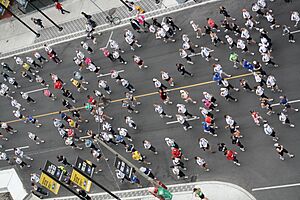
The surface for road races is very important. World Athletics says courses must be on man-made roads, bike paths, or footpaths. Courses on major city roads are common for road running events. Traffic is usually blocked off during the race. Soft ground like grass is generally avoided. But races might start and finish on soft ground or inside an athletics stadium.
Road racing courses come in two main types: looped and point-to-point. Courses can be measured to cover a standard distance, like 10 km (6.2 mi). Or they might just follow a set route between two landmarks.
Road running courses over 5 km usually have drink or refreshment stations for runners. These are at specific points along the course. Medical staff are also present at major races. This is because long-distance running can have health risks.
Elite racewalking events happen on closed loop courses. These are usually loops of 2,000 or 2,500 meters. Refreshment stations are also available for long-distance walking races. Drinks are offered on every lap for races longer than 10 km.
Athletics Organizations
In 1912, the international governing body for athletics was formed. It was called the International Amateur Athletics Federation. In the late 1970s, the sport moved from being amateur to professional. So, the word "amateur" was removed from the name. The organization became the International Association of Athletics Federations in 2001. In late 2019, it changed its name again to World Athletics.
World Athletics has 215 member nations and territories. These are divided into six continental areas. The six areas are Asia, Africa, Europe, Oceania, North and Central America and Caribbean, and South America. The different sports within athletics don't have their own separate groups. Instead, they all fall under the main athletics authorities.
- AAA – Asian Athletics Association
- CAA – Confederation of African Athletics
- CONSUDATLE – South American Athletics Confederation
- NACACAA – North America, Central America and Caribbean Athletic Association
- EAA – European Athletics Association
- OAA – Oceania Athletics Association
National athletics organizations manage the sport in their own countries. Most major competitions need a permit or approval from their national group.
Athletics Competitions
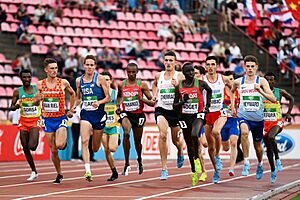
Athletics competitions can be split into three main types: international championships, national championships, and yearly meetings/races. International championships, or Games, are the top level of competition. Athletes represent their country or region. These events are usually run by a world, continental, or regional athletics group. Athletes get to compete by being chosen by their national athletics group. This is often based on their past achievements or performance at a national selection event.
National championships are yearly competitions approved by a national group. They decide the country's best athlete in each event. Yearly one-day meetings and races are the most basic and common type of athletics contest. These events are often by invitation. They are organized by sports groups, promoters, or other organizations.
Competitions usually feature only one type of athletics sport. However, major outdoor international athletics championships and athletics events at multi-sport events often combine track and field, road running, and racewalking.
International Competitions
Multi-Sport Events

The modern Summer Olympics was the first event to have a global athletics competition. All four main athletics sports have been in the Olympic athletics program since it started in 1896. Cross country has since been removed. The Olympic competition is the most famous athletics event. Many athletics events are among the most watched at the Summer Olympics. A total of 47 athletics events are held at the Olympics: 24 for men and 23 for women (as of London 2012). The men's and women's events are mostly the same or similar. The only difference is that men compete in the 50 km race walk.
After the Olympics, other multi-sport events started in the 1900s. These included athletics as a main sport from the beginning. Examples are the Commonwealth Games, the Central American and Caribbean Games, Universiade, and many others.
The Summer Paralympics include athletes with a physical disability. Track and field, and road events have been in the Paralympic athletics program since it started in 1960. The Paralympic competition is the most important athletics event for athletes with a physical disability. Athletics at the Paralympic Games also includes wheelchair racing. Here, athletes compete in lightweight racing chairs. Athletes with a visual impairment compete with a sighted guide. At the 2012 Summer Paralympics in London, guides received medals for the first time in an international athletics event. This is like pilots in cycling and guides at the Paralympic Winter Games.
World Championships
The World Athletics Championships is the main global athletics championship held by World Athletics. This competition happens every two years. It started in 1983. Now, its events are the same as the Olympics. So, road running, racewalking, and track and field are featured. Cross country running has its own global championship, the World Athletics Cross Country Championships. This has been held every year since 1973. The World Athletics Indoor Championships is a biennial athletics championship. It only features indoor track and field events.
The most important separate road running event is the yearly World Athletics Half Marathon Championships. While not an official world championship, the biennial World Athletics Race Walking Team Championships serves a similar role for racewalking. Outdoor track and field is the only athletics sport without its own global championship separate from other types of athletics. However, the IAAF Continental Cup (a competition every four years between continental teams) is only outdoor track and field events.
Other world championships include the World Athletics U20 Championships and the now-closed World Youth Championships in Athletics. These were for athletes under 19 and under 17. World Masters Athletics holds the World Masters Athletics Championships for athletes in 5-year age groups over 35. The now-closed IAAF World Road Relay Championships was the global event for ekiden marathon relay races.
Elite athletes with a physical disability compete at the World Para Athletics Championships.
Area and Continental Championships
African, Asian, European, North & Central and Caribbean (NACAC), Oceania, and South American Athletics Championships are held regularly. They come in different forms. For example, the Oceania Area Championships in Athletics are combined with the Oceania U20 Athletics Championships. Most main regions have separate cross-country, road-running, and marathon championships.
There is also the Pan American Combined Events Cup. Central American and Caribbean Championships are organized by the Central American and Caribbean Athletic Confederation (CACAC).
See also
 In Spanish: Atletismo para niños
In Spanish: Atletismo para niños
- List of films about the sport of athletics
- List of Olympic medalists in athletics (men), (women)
- List of world records in athletics
- World records in athletics (athletes with a disability)
- National records in athletics
- Association of Track and Field Statisticians
- Running in Ancient Greece
- USA Outdoor Track and Field Championships
- World Athletics Championships
- Diamond League


